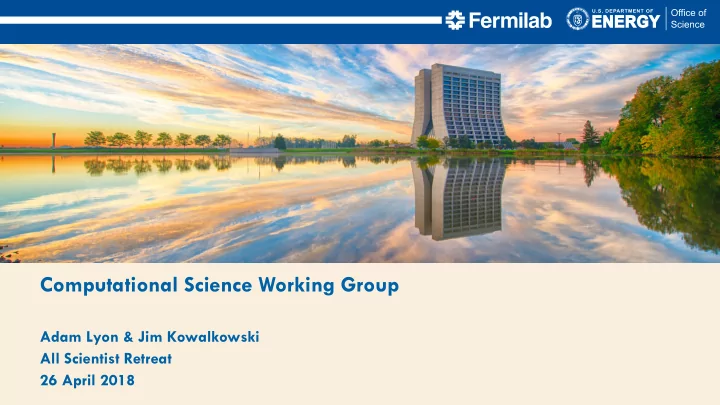

Computational Science Working Group Adam Lyon & Jim Kowalkowski All Scientist Retreat 26 April 2018
Micro-workshop https://indico.fnal.gov/event/16923/ Watch the movie! � 2
Charge Addressing 2nd and 3rd charge items… Structures are in place to identify cross-cutting R&D opportunities and advise funding agencies — Fermilab has important involvement � 3
Community White Paper (CWP) International effort to determine R&D Roadmap for HL-LHC (and DUNE) Stewarded by HSF — Fermilab input into nearly all reports � 4
S2I2 —> IRIS Community White Paper reports inform NSF on establishing a software institute Scientific Software Innovation Institute (S2I2) —> Institute for Research in Innovative Software (IRIS) NSF funded; Lead by Peter Elmer, Mark Neubauer, Mike Sokoloff Delayed start due to budget uncertainty Will focus on HL-LHC Software R&D Coincidental overlap with neutrino/muon needs may be exploited � 5
DOE Funds Computing R&D… ASCR funding to HEP… OHEP with COMPHEP and CCE • SciDAC (Scientific Discovery though Advanced • Detector Simulations (Geant) Computing) • Accelerator Simulations • $17.5M awarded to FNAL: two 5 year projects • Software Frameworks including new and one 3 year project architectures • Accelerator Modeling (5yr) • Big Data & Machine Learning Reconstruction on advanced architectures (3yr) • HEP Data Analytics on HPC • Running on HPC (Supercomputers) LHC/Neutrino Science, Optimization, Storage • Lattice QCD (joint with NP) and Data Modeling, Workflow (5yr) Problem well suited to early adoption of HPC technology CMS Computing & Software R&D • Exascale Computing Project for Lattice QCD • (joint with BNL, JLab) ASCR Office (Advanced Scientific LDRD: Off-the-shelf DAQ; Databases for Big Data; HEP Computing Research) with Micron Automata; Preparing HEP for Exascale, QC, ML • Operates HPC centers (ALCF, OLCF, NERSC) • HPC R&D � 6
HEP Data Analytics on HPC SciDAC (JBK) � 7
What will Computing Look Like > 2026? SciFi says your screen will be blue (unless you are a terminator ) https://99percentinvisible.org/episode/future-screens-are-mostly-blue/ Make It So: Interaction Design Lessons from Science Fiction � 8
What will Computing Look like > 2026? We know shorter term, but not long term … won’t try to guess Instead, think about what we’ll be doing in 2026+ How would computing support that science? What Three areas for R&D are the computing trends? A) Computational Software What R&D would be necessary and make a roadmap. B) Operating Computing Systems C) Data Acquisition Three “triggers” for Computational R&D… 1) Receive requirements from experiments based on upcoming needs 2) Forward thinking to keep up with the evolving computing landscape 3) Useful technologies that scientists adopt and needs support � 9
Timeline JBK � 10
Where is Computing Going? Moore’s Law: # of transistors doubles every two years Dennard Scaling: Power/transistor decreases so clock speeds can increase without increasing total power consumed Clock speeds have been constant for 10 years Can’t make cores faster, so give you more of them Multiprocessors Multithreading I’ve mentioned R&D already � 11
Exascale Computing Massively parallel Supercomputers (NSCI/ECP) [Major challenge is energy efficiency] CORI (NERSC): 153K Haswell Threads 2.6M KNL Threads Summit (ORNL): 27K GPUs; 9.2K POWER9 Important for ML training Aurora (ANL): Was to be next generation KNL Now likely an “extreme heterogeneity” machine Specialized hardware for Big Data, ML, HPC Details yet to be revealed - targeted for ~2021 Much R&D now and short term future to learn how HEP can effectively use these resources (vectorization and multithreading) � 12
R&D Necessary Post-Moore Computing for HEP to adopt Reach the limit of # of transistors on a chip (probably around 2020) New and different computing emerges — ASCR is driving (Machines with CPUs, GPUs, TPUs, …) ; massive memory replacing massive storage JBK � 13
CMS R&D Oli � 14
CMS R&D List is not exhaustive More cores, less memory GPUs, FPGAs Parallel Kalman, GeantV NanoAOD Data Lakes Big Data, HPC HEPCloud Software Defined Networking Containers Oli � 15
Other Software R&D Machine learning for full reconstruction and simulation Vectorization and parallelization at algorithm level (reco/sim) Auto optimized code generation for heterogeneous systems Continue our strategy of COMMON TOOLS ROOT: Pass through i/o, i/o for parallelization, object stores Frameworks: reduce dependencies, functional programming, whole-dataset operations, programming/data models NOT tightly coupled to language, tiered memory usage ML on diverse hardware FPGAs closely interconnected to CPUs (ML, triggering, reconstruction, analysis) Worry: What do we do when Quantum Computing breaks all encryption? � 16
Future experiments Future EF (Higgs factory/100 TeV pp) go far beyond HL-LHC The technology needed to step beyond HL-LHC may be a ways off R&D for HL-LHC should be a good guide Future CF (LSST/DESC/CMB-S4) Very large data sets; image processing; spatial processing Common workflow important � 17
DAQ DOE DAQ Workshop 10/17 Alan CCD/MKIDS DAQs — ~0.5M detectors at high rates, warm electronics, RF controls may be useful for Quantum Computers � 18
How are we moving forward? Execute the R&D Projects we have now and succeed Follow on with new proposals and projects Continue to engage ASCR (they’re driving the paradigm shifts in the US) Work with our partners and plan the future Universities helped by IRIS Other labs helped by CCE Internationally helped by HSF Must be aware of what’s happening Maintain our leadership in HEP Computing R&D in the computing neighborhood Can’t let the future get the jump on us � 19
We do Computing R&D to support and enable the Physics � 20
Recommend
More recommend